There is no doubt that in today’s fast-paced, visual world, attention spans fade in the blink of an eye, so this type of highly engaging visual content has become the secret weapon to capture attention and achieve effective communication.
Whether we’re talking about an eye-catching graphic on a billboard or a whimsical illustration in a children’s book, the power of visuals can be seen in their ability to captivate, inform, and inspire the public.
So, just as the saying goes, “A picture is worth a thousand words,” and in marketing, this can be worth a thousand conversions.
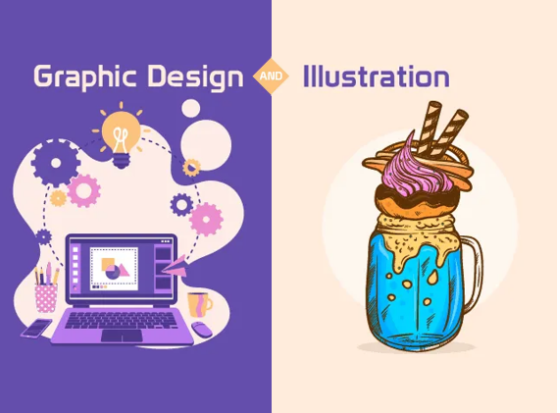
But here’s where the interesting part begins: not all visuals are created equal. That’s why today we’ll mention the difference between graphic design and illustration, which are two distinct visual languages, each with its own style and purpose.
Understanding their differences will help you know which one to choose, or even combine both, when you need to and want to bring your creative vision to life. So, let’s dive into the colorful world of graphic design and illustration and explore what motivates them, how they differ, and when to use them to your advantage.
The Art of Graphic Design: Communication with Strategy
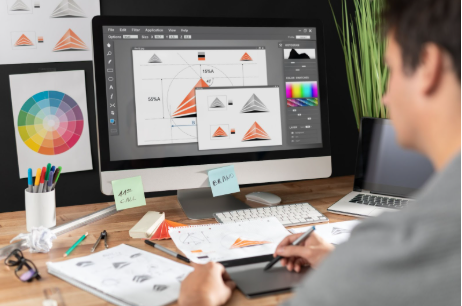
Graphic design is about making things look pretty and solving projection problems through visual communication. Think of it as one of the translators between your brand and your audience, where you must ensure that the message is understood loud and clear.
Keeping in mind the balance of creativity and strategy, graphic design transforms ideas into visual elements that speak directly to your target audience.
At its core, graphic design combines text, images, and colors to create complete designs that inform, persuade, and inspire. It is a practical art with foundations in research and intentional choices.
In this sense, graphic design encompasses two main mediums:
- Print design: from business cards to posters, brochures, and product packaging. Print design covers everything tangible. These designs often serve as a brand’s first handshake, leaving a lasting impression.
- Digital design: includes websites, apps, social media graphics, and motion graphics. It is dynamic and often incorporates interactive elements or animations to engage users.
Now, the prominent areas of graphic design include:
- Web design: Ever wonder why some websites seem so easy to navigate? That’s the magic of web design, where visual meets functionality to create seamless user experiences.
- Brand identity design: Is how a brand is born visually. Logos, company stationery, and marketing materials all contribute to a brand’s visual identity. Good design ensures that these elements work together to tell a coherent story and personality.
- UI/UX design: User interface (UI) and user experience (UX) designers focus on creating intuitive and easy-to-interact digital spaces. They design buttons, menus, and panels that guide users effortlessly through apps and websites.
- Motion graphics: From animated ads to dynamic typography in videos, motion graphics bring designs to life in the digital world.
Graphic designers’ creative process is both analytical and imaginative. It involves understanding the audience, researching trends, and carefully selecting fonts, colors, shapes, and layouts to ensure the final design achieves the desired impact.
The Magic of Illustration: Where Imagination Soars
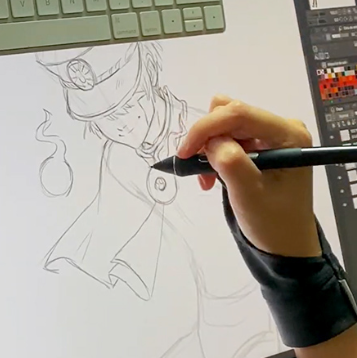
Now that we know graphic design is a creative-methodical communicator, we can understand illustration as its more free-spirited sister: an art form that thrives on creativity and storytelling, where the primary intention is to evoke emotions, spark the imagination, and weave narratives that linger in the mind.
Illustrations take many forms, each offering a unique way to bring stories and concepts to life.
Here are the four main categories:
- Illustrative Drawings: Drawings, whether pencil sketches, inked comics, or charcoal masterpieces, are the foundation of illustration. They are often used for storyboards, concept art, and visual storytelling.
- Illustrative Paintings: Acrylics, watercolors, and digital brushstrokes mimic the textures and styles of traditional paintings, adding depth and personality to the artwork.
- Illustrative Crafts: From paper art and woodcuts to textile designs, crafts infuse tangible art into visual storytelling. They often combine tactile techniques with a creative vision.
- Digital Illustrations: Combining traditional art with cutting-edge technology, digital illustrations are created using tools like Adobe Illustrator and Photoshop. They are the ideal choice for illustrations intended for digital platforms.
What sets illustration apart is its focus on artistry and emotional resonance. This is why it is considered the perfect medium for children’s books, movie storyboards, comics, editorial art, or any project where creativity is the focus.
Graphic Design vs. Illustration: Here’s the Difference
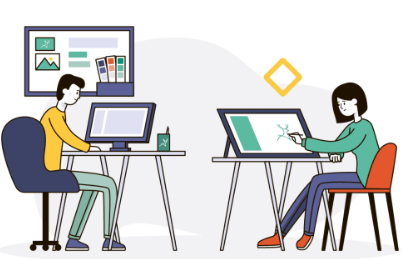
At first glance, graphic design and illustration may seem similar.
After all, they both involve creating visual elements.
However, their purposes, processes, and applications are slightly different.
| Aspect | Graphic Design | Illustration |
| Goal | Communicate clearly and inspire action. | Tell a story or evoke emotions. |
| Primary Use | Corporate and commercial visuals | Artistic and narrative content. |
| Mediums | Print and digital (flyers, websites, etc.). | Traditional and digital art forms. |
| Focus | Practical and strategic design. | Creative and expressive storytelling. |
| Examples | Ads, logos, infographics, web interfaces. | Book covers, comics, storyboards, art. |
Graphic design thrives most in structured business contexts where clarity and functionality are key. Illustration, on the other hand, shines in creative spaces where emotions and imagination take the lead.
When Two Worlds Meet: Ideal Combination, Graphic Design and Illustration

Why choose one when you can have both? Some of the most memorable visual projects combine the precision of graphic design with the art of illustration.
For example:
A branding campaign might include a clean, professional logo (graphic design) along with custom illustrations for marketing materials (illustration)
A children’s book might feature carefully designed layouts incorporating fun, hand-drawn illustrations.
Or a social media campaign might use graphic design for consistent branding and illustrations to add personality and charm.
And when used together, graphic design and illustration can enhance each other, resulting in images that are not only beautiful but impactful.
Which approach should you choose for your project?
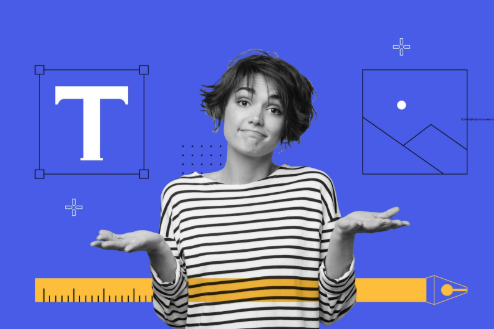
So, how do you decide whether to use graphic design, illustration, or both?
It all depends on your project goals.
Use graphic design if…
It would help if you had clear, practical communication.
You’re creating branding, marketing materials, or web designs.
Or you want polished visuals that align with your company’s identity.
Use illustration if…
Your project is more creative or narrative.
You want to evoke emotions or tell a story.
Or you’re designing for artistic or editorial purposes.
Just remember: If your project requires both precision and imagination, don’t hesitate to combine the two. The result could be a masterpiece that balances strategy with creativity.
Finally, rely on visual content: the key to standing out.
With so much content saturation out there, visuals remain the most powerful tool for capturing attention and leaving a lasting impression. Whether it’s a sleek graphic or a captivating illustration, choosing the right visual approach can determine the success or failure of your project.
So, the next time you’re brainstorming ideas for a campaign, product, or creative project, remember the unique strengths of graphic design and illustration. By harnessing their potential to tell your story, you’ll connect with your audience and stand out in a sea of visuals.
After all, when done right, visual content communicates and resonates. And that’s what makes it unforgettable.
